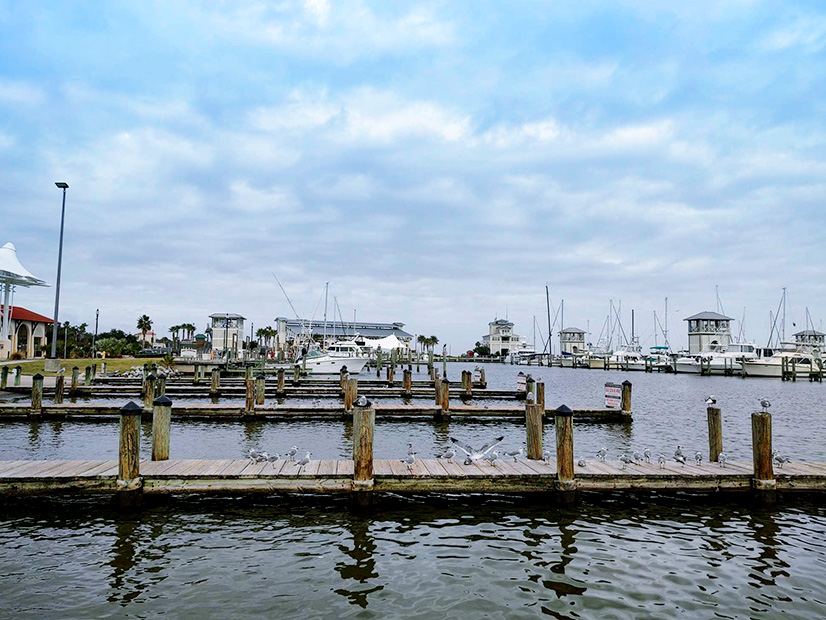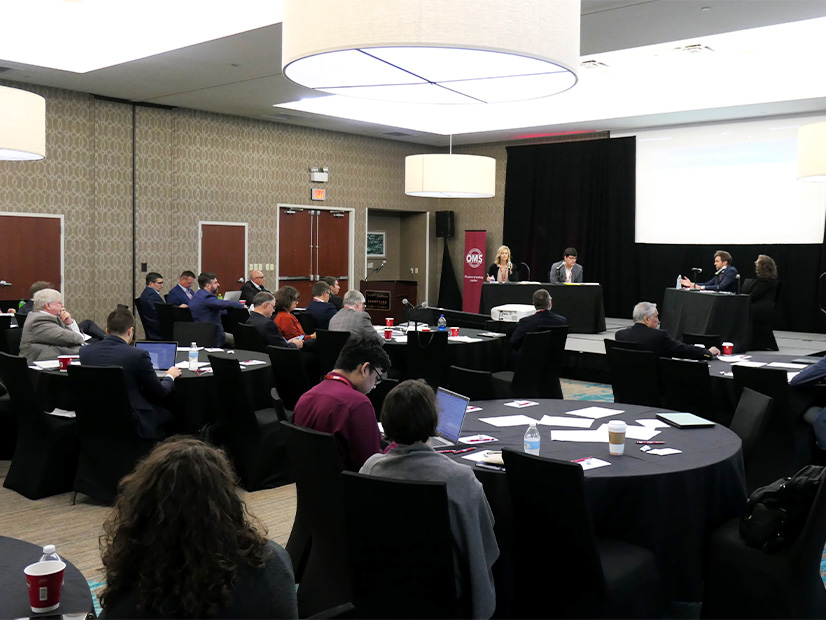
GULFPORT, Miss. — The Organization of MISO States took time to celebrate its 20-year anniversary at its annual meeting while exploring familiar themes of restructuring resource adequacy and barriers to large transmission buildout.
OMS was incorporated in mid-2003, two years before MISO’s energy markets went live. Former OMS board members and chairs reminisced about the past two decades of the organization during the Oct. 26 meeting.
Bill Smith, OMS’ original executive director, said he hatched a nascent idea for the organization by scrawling notes on a “too early” flight. He said OMS was formed before cellphones and even conference calls.
“We were working in a different kind of technology,” Smith said.
Founding OMS board member Steve Gaw said state commissions at the time were looking for a way to bridge state matters with RTO and federal matters.
Gaw said commissioners were motivated to form OMS based in part on a worry that if they didn’t do it, someone else might. He said initially, founding members didn’t know how they would conduct meetings and get funding, or whether MISO would object to the organization’s creation and how much information the RTO would share with it.
“I didn’t know if this was going to be a long-lived thing, or if someone would challenge it or in two to three years, [or] it would go away,” Gaw said. “The reason it’s still here is because it’s valuable.”
Gaw said several commissioners involved in OMS still share a spirit of working together and moving past differences.
David Boyd, former OMS board member and Minnesota commissioner, said the Minnesota Public Utility Commission didn’t create staff positions dedicated to RTO matters until funds were freed up with the Emergency Economic Stabilization Act of 2008 (the so-called Wall Street bailout). He said OMS is key to state collaboration and understanding MISO initiatives.
“You felt like you had colleagues all across the country,” former OMS President and Michigan Public Service Commission Chair Sally Talberg said.
Outgoing OMS President and current Michigan PSC Chair Dan Scripps said organization leadership this year focused on making it more unified. He said it was a strategic choice to have OMS’ 20th annual meeting in a MISO South state.
“There are regional differences; there are state differences; but they make us stronger,” Scripps said.
The OMS Board of Directors unanimously elected Wisconsin’s Tyler Huebner to serve as the 2024 president.
Also at the meeting, members created the David Carr Award for Outstanding Staff Contributions, an annual award for regulatory staffers and named for Mississippi Public Service Commission counsel David Carr, who died in late December. Carr’s father, Mississippi PSC Commissioner Wayne Carr, received a standing ovation upon the award’s unveiling.
Werner Roth, an economist at the Public Utility Commission of Texas who helps chair multiple MISO stakeholder committees, is the award’s first recipient.
Reconsidering Resource Adequacy
Sixteen years after OMS helped shape MISO’s first comprehensive resource adequacy plan, regulatory staffs are again rethinking the RTO’s RA construct and invited experts to speak at the meeting on what they would prescribe.
National Association of Regulatory Utility Commissioners staffer Elliott Nethercutt said with 72% of the nation’s dispatchable, on-demand generation expected to retire by 2040, the entire industry must reconsider RA. He predicted state regulatory organizations like OMS are going to become even more critical as states test approaches to decarbonization.
Kelli Joseph, of the University of Pennsylvania’s Kleinman Center for Energy Policy, called for “coordinated, reliability-informed” RA and operating reliability planning in which states and RTOs alike have a role. RTOs should assess states’ resource plans collectively and advise on red flags, she said. That way, states could understand the effect of their resource planning decisions on other states.
“The lack of this type of planning is a reliability risk,” Joseph said.
In addition to operating reserves, Joseph said grid operators need resources that meet public policy goals alongside “balancing resources,” or quick-start, fast-ramping resources in the form of either gas or batteries.
Joseph said scarcity pricing “has never been a sufficient investment signal to meet reliability targets”; that’s becoming especially apparent in the resource transition. She said LMP is helpful only to encourage short-term dispatches, and “using a price alone” to incent the entry of certain types of resources is flawed.
“I think we’re at the point where we need to have conversations about what we’re doing: … what is the public good, and what are we doing to manage this public good of a reliable electric system?” she said. “It’s too essential to get this wrong.”
“It’s hard to have long-term market signals,” agreed former Arkansas Public Service Commission Chair and Energize Strategies founder Ted Thomas. The system needs a “sharing of responsibility and sharing of costs” when it comes to operations reliability.
“Who wants to be the regulator to put in a gas plant with carbon capture with a per-unit cost of a gazillion? Who here wants to do that?” he asked rhetorically.
Joseph said RTOs could help states determine if they want to divvy the costs of building critical but seldom-used resources.
Thomas said MISO’s filing at FERC for a sloped demand curve in its capacity market exemplifies the consequences of states’ inaction. From 2015 onward, states protested MISO’s suggestion to use a sloped demand curve in the auction, insisting it would impede states’ authority on resource planning — that is, Thomas said, until the 2022/23 Planning Resource Auction cleared Midwestern zones at a $240/MW-day cost of new entry. (See MISO’s 2022/23 Capacity Auction Lays Bare Shortfalls in Midwest.) He said after that, states asked MISO, “‘What are you going to do about this?’” resulting in the sloped curve’s rebirth.
“We have to get in front of this if we want jurisdiction. Because we have a problem, and if we don’t get ahead of it, we’re going to get the sledgehammer and, with it, a chunk of our jurisdiction [taken away],” Thomas said.
North Dakota Public Service Commissioner Julie Fedorchak said that while she isn’t worried about RA in the long run, she is worried about the next five years “because everyone is really eager to get going on these goals” and shift the resource mix without enough attention on how demand will be met at all times.
“This is not a place for experimentation. This is the foundation of our society, and we have to get it right,” Fedorchak said.
Thomas also said he wished EPA would reread MISO’s comments raising the alarm on the agency’s new proposed emissions standards for power plants. The RTO said the proposal would supercharge retirements so they outstrip the commercialization of new technologies like green hydrogen and carbon capture. (See EPA Power Plant Proposal Gets Mixed Reception in Comments.)
He also said there is currently a lack of balance in political power over energy decisions, as the left has taken the lead over decisions on the energy transformation.
“The right has no credibility because they’re on a hangover from climate denial. They have no credibility right now to say the science might be exaggerated,” Thomas said.
Overcoming Transmission Planning Challenges
Regulators also touched on the venerable subject of stumbling blocks to transmission planning while the federal government pushes for a sturdier system.
Grid United CEO Michael Skelly said he views new transmission lines as essential to maintaining RA while dealing with load growth, two topics on his mind lately.
Panelists agreed that long-distance buildouts are useful to dodge blackouts during extreme events.
“Look at [Winter Storm] Uri: We’re paying no matter what we do. I don’t know about the rest of the world, but in Texas, we’re paying $9/month for pretty much ever,” Skelly said.
MISO long-term planning studies and revived federal studies like the National Transmission Planning Study to pinpoint beneficial line routes embody the Hippocratic Oath of “first, do no harm,” Skelly said. “I think if you look at all these studies and squint, it’ll point the way.”
“Projects are not shockingly hard to come up with. We’ve seen the same lines come up time and time again,” MISO Senior Vice President of Planning and Operations Jennifer Curran said of interregional transmission needs under MISO’s Joint Targeted Interconnection Queue (JTIQ) portfolio of 345-kV lines. The $2 billion portfolio has received $464 million from DOE under the Infrastructure Investment and Jobs Act. (See DOE Announces $3.46B for Grid Resilience, Improvement Projects.)
Curran said that while line needs are relatively easy to deduce, how to share the costs of those lines is a major sticking point that slows the transmission planning process. MISO is trying to reproduce a JTIQ-style study for its seam with PJM, but Curran expressed reservations over the differences between the RTOs’ planning styles.
“SPP and MISO think about transmission planning very similarly. PJM and MISO do not. We’re going to try, but I have my optimism a little tempered,” she said.
Serving as moderator, OMS President Scripps joked that sometimes when he looks at the overlays of prescribed transmission line opportunities and thinks of all the permitting and cost allocation obstacles that can topple them, he is sometimes “bullish” on a future with high distributed energy resources instead.
“This is a very exciting time to be doing this,” Skelly countered. “This must have been how it felt to develop infrastructure in the ’60s. Because people want so much of it.”
But Skelly said too much is heaped on the transmission siting process, including environmental concerns, land acquisition, some cost allocation details and landowner concerns.
“We really burden the siting process with a lot of stuff,” he said. “That’s a lot to put into one process.”
Skelly said Grid United is trying to “de-pancake” siting by isolating risks to development and handling land acquisition of routes first before moving onto other steps of the process.


